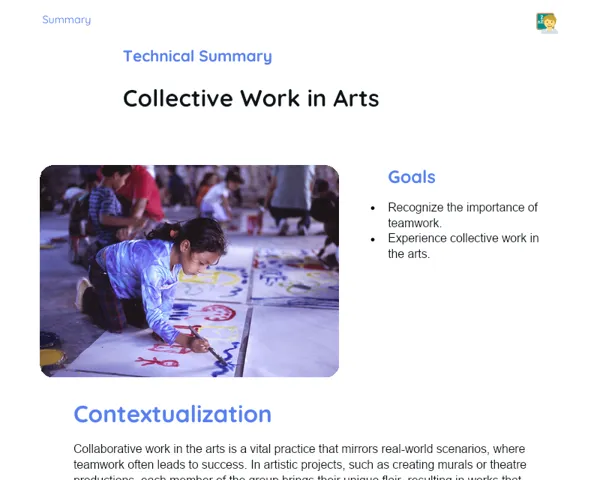Socioemotional Summary Conclusion
Goals
1. Understand Byzantine art as a manifestation of Eastern Christian art, identifying its key features in architecture, paintings, and mosaics.
2. Recognize the historical and cultural significance of Byzantine art and its impact on medieval European art.
3. Develop critical analysis skills when observing Byzantine artworks, focusing on the emotional and social themes they express.
Contextualization
👀 Did you know that Byzantine art serves as a fascinating window into the spirituality and culture of the Byzantine Empire? 🏛️ Imagine walking into a church with stunning domes, walls adorned with shimmering mosaics, and paintings that narrate the tales of ancient times. It’s akin to a journey through history, evoking the emotions and beliefs of a different time! Shall we embark on this captivating exploration together? 🌟
Exercising Your Knowledge
Byzantine Architecture
Byzantine architecture is famed for its grand domes, especially the magnificent Hagia Sophia, alongside the elaborate use of intricate mosaics. Typical Byzantine churches feature a centralized layout, with a prominent central dome symbolizing heaven, creating a spiritually uplifting atmosphere.
-
Majestic Domes: The domes of Byzantium, particularly the one at Hagia Sophia, stand as architectural icons symbolizing the link between the divine and the earthly. 🌌
-
Ornate Mosaics: Crafted from tiny pieces of glass, stone, or ceramics, Byzantine mosaics narrate biblical stories and portray religious figures, evoking deep emotions and spiritual insights. 🎨
-
Centralized Plans: The centralized design of Byzantine churches emphasizes verticality and centrality, enriching the spiritual experience and connection to the divine. 🏛️
Byzantine Paintings
Byzantine paintings, particularly known for their religious icons, depict sacred figures such as Christ, the Virgin Mary, and saints. These icons are more than mere artwork; they are revered as windows to the divine, inspiring devotion and reflection.
-
Religious Icons: Icon paintings are respected as divine figures, integral to practices of devotion and contemplation. ✨
-
Rich Symbolism: Each detail in Byzantine paintings holds symbolic significance, from vibrant colors to the figures' postures, delivering profound spiritual narratives. 💫
-
Stylized Style: The gracefully elongated figures and serene expressions in Byzantine paintings reflect the peace and eternity of spiritual existence. 🙏
Byzantine Mosaics
Byzantine mosaics are among the most striking forms of Byzantine art, made from small shards of glass, stone, or ceramics, artistically arranged to create intricate and vivid images. These artworks embellish the walls and ceilings of churches, fostering a divine and contemplative space.
-
Technique and Precision: Crafting mosaics demands a high degree of skill and patience, with each piece carefully positioned to form a unified image. 💎
-
Use of Colors: Renowned for their vivid hues and golden backgrounds, Byzantine mosaics symbolize divine radiance and spiritual grandeur. 🌟
-
Emotional Impact: The imagery created by mosaics is deeply impactful and resonates with emotions of reverence, admiration, and introspection. 🌈
Key Terms
-
Byzantine Art: An artistic style developed in the Byzantine Empire between the 4th and 15th centuries, characterized by its religious imagery and stunning architecture.
-
Dome: A rounded and vaulted architectural feature, symbolizing the heavens and a core element in Byzantine design.
-
Mosaic: The art of assembling images from small pieces of glass, stone, or ceramics, extensively used in the decoration of Byzantine churches.
-
Icon: A revered religious painting in Eastern Christianity, illustrating sacred figures such as Christ, the Virgin Mary, and saints.
-
Centralized Plan: An architectural design where space is organized around a central point, commonly found in Byzantine churches.
For Reflection
-
How does Byzantine art utilize symbolism to express emotions and spiritual messages? See if you can identify similar symbols in other art forms and compare them to those in Byzantine art.
-
Did you feel a sense of calm and focus after the guided meditation? In what ways can this practice assist you in other areas of your life, such as studies or personal relationships?
-
While creating your own mosaic, how did you handle feelings of frustration or joy? What strategies did you adopt to overcome obstacles and express your creativity?
Important Conclusions
-
Byzantine art is a rich and symbolic representation of Eastern Christian artistic expression, characterized by its awe-inspiring architecture, iconic paintings, and intricate mosaics.
-
The domes, mosaics, and icons of Byzantine art not only serve as decoration but also convey profound emotions and spiritual insights.
-
Studying Byzantine art allows us to appreciate its historical and cultural influence on medieval European art and its symbolic significance.
Impacts on Society
In today's world, Byzantine art continues to inspire artists and architects globally. Its techniques and styles are evident in contemporary works, from architectural designs to cinematic productions, where grandiosity and spirituality play central roles. Furthermore, preserving Byzantine monuments and artworks helps us honor the historical and cultural legacy of past civilizations, linking us to our roots and traditions.
In an emotional context, Byzantine art teaches us the value of contemplation and devotion. When we view an icon or mosaic, we are prompted to reflect on our own beliefs and feelings, forming profound emotional and spiritual connections. These works encourage us to delve deeper than surface appearances, inspiring us to find meaning and purpose in our everyday lives and emotions.
Dealing with Emotions
At home, consider practicing the RULER method to navigate your emotions while studying Byzantine art. Start by recognizing how you feel—are you intrigued, captivated, or even overwhelmed? Next, explore what may be causing that emotion—perhaps the captivating history is drawing you in or the techniques appear complex. Label that feeling accurately as 'curiosity' or 'overwhelm.' Share those emotions appropriately, maybe by discussing with classmates or jotting down your thoughts. Finally, regulate your emotional state by establishing strategies to remain motivated, such as setting small study goals or taking moments for reflection.
Study Tips
-
Explore virtual museums or browse online art galleries showcasing Byzantine art collections. This will enhance your understanding of the techniques and styles we discuss in class.
-
Keep a study journal to jot down your reflections on the emotions you experience while learning about Byzantine art and how you manage them. This will bolster your self-awareness and self-regulation.
-
Form study groups with your classmates to discuss and analyze Byzantine artworks together. Sharing thoughts and perspectives can enrich your learning experience, making it more dynamic and cooperative.



